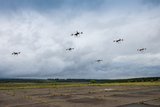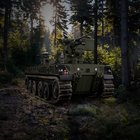CUV debuts new tactical aerostat
The latest version of Carolina Unmanned Vehicles’(CUV) Small Tactical Multi-Payload Aerostat System (STMPAS), called STMPAS-II has made its debut at the North Carolina Federal Advanced Technologies Review (NCFATR) at the McKimmon Conference & Training Center in Raleigh.
The original STMPAS system was developed for the Army Rapid Equipping Force (REF), for deployment to Afghanistan, where it provided ISR capabilities for small tactical units. Eight units in total were acquired by the REF.
CUV has developed STMPAS-II to carry ISR and communications payloads attached under a small specially designed tethered blimp, called a Helikite.
STMPAS-II improvements include launch directly from a box on the trailer top rather than from the ground, improving launch time and reducing issues with muddy or rocky ground, while allowing movement of the system with the Helikite inflated atop the trailer.
The Helirest air inflated unit has been moved to the trailer top where it restrains and protects to the Helikite during inflation, deflation and ground storage. Winch models are available that can accommodate up to 10,000 ft of tether, and can be equipped with electrical slip rings and fibre optic rotary joints for power/data tethers. Several models of on-board generators are also available.
The STMPAS blimp can fly at altitudes of 500 to 10,000 ft for long term coverage for 24 hours a day for a week or more without maintenance or downtime. Unlike many aerostats, the system can operate in high winds due to Helikites’ lifting surfaces that generate aerodynamic lift to support the blimp in winds. This allows STMPAS to be smaller and more mobile than traditional aerostat systems while still operating in high winds.
STMPAS is designed to support mobile or expeditionary operations, but may be employed in static missions such as a force protection measure at a small Forward Operating Base (FOB) that cannot logistically support a larger aerostat system. It can also be used for mobile border security and post-disaster communications support.
More from Uncrewed Vehicles
-
![US Navy foresees an uncrewed future for its surface and underwater fleet]()
US Navy foresees an uncrewed future for its surface and underwater fleet
The service has been conducting various procurement and development efforts to integrate unmanned surface and underwater vehicles into its inventory.
-
![Ready for the race: Air separation drone swarms vs. air defence systems]()
Ready for the race: Air separation drone swarms vs. air defence systems
As the dynamics of aerial combat rapidly evolve, Chinese scientists have engineered a sophisticated air separation drone model that can fragment into up to six drones, each capable of executing distinct battlefield roles and challenging the efficacy of current anti-drone defences such as the UK’s Dragonfire laser system.
-
![Israel’s MALE UAVs ‘must adapt’ to Iranian-made air defences]()
Israel’s MALE UAVs ‘must adapt’ to Iranian-made air defences
Advancements in air defence technologies have begun to reshape aerial combat dynamics in the Middle East, as illustrated by recent events involving the Israeli Air Force and Hezbollah.
-
![Hundreds more UAS sent to Ukraine forces with thousands more on the way]()
Hundreds more UAS sent to Ukraine forces with thousands more on the way
Both sides of the Russia-Ukraine war have been using UAS for effective low-cost attacks, as well as impactful web and social media footage. Thousands more have now been committed to Ukrainian forces.
-
![AI and software companies selected for US Army Robotic Combat Vehicle subsystems]()
AI and software companies selected for US Army Robotic Combat Vehicle subsystems
The US Army has intentions to develop light, medium and heavy variants of the Robotic Combat Vehicle (RCV) as part of the branche’s Next Generation Combat Vehicle family.

























